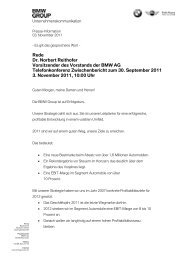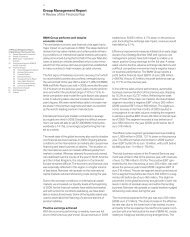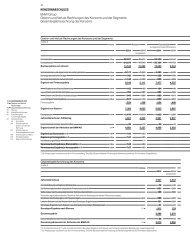Sustainable Value Report 2001/2002 - BMW Group
Sustainable Value Report 2001/2002 - BMW Group
Sustainable Value Report 2001/2002 - BMW Group
You also want an ePaper? Increase the reach of your titles
YUMPU automatically turns print PDFs into web optimized ePapers that Google loves.
28<br />
The environmental impact of an automobile<br />
must be taken into consideration throughout<br />
its entire lifecycle. <strong>BMW</strong> consistently pursues<br />
comparative lifecycle analysis (eco-balance)<br />
for components as continuous optimization<br />
process within the product development phase.<br />
The goal is to design environment-friendly<br />
products. Lifecycle-analysis of components<br />
includes design and engineering operations,<br />
as much as it does manufacturing and assembly,<br />
sales & service, and final recycling of end-of-life<br />
vehicles.<br />
In compliance with ISO 14040 eco-balance<br />
guidelines, a detailed analysis is made of the<br />
potential environmental impact of each product.<br />
This leads to further improvements and<br />
recommendations. From the very beginning of<br />
the product development process, this analysis<br />
is consistently applied in designing <strong>BMW</strong> parts.<br />
Within the framework of this approach, a<br />
careful assessment is made to determine, for<br />
example, whether steel should be replaced<br />
with other materials, e.g. aluminum, magnesium,<br />
or plastics, to reduce vehicle weight and lower<br />
fuel consumption as well as exhaust emissions.<br />
The goal is it to minimize the environmental impact of the automobile<br />
over the entire product lifecycle to meet the needs of human health<br />
and our natural habitat.<br />
<strong>BMW</strong> fleet fuel consumption for new registered vehicles in Germany<br />
(DIN 1/3 mix, weighted according to number of vehicles)<br />
120%<br />
110%<br />
100%<br />
90%<br />
80%<br />
70%<br />
60%<br />
50%<br />
VALVETRONIC: Revolutionary engine<br />
design<br />
’78 ’80 ’82 ’84 ’86 ’88 ’90 ’92 ’94 ’96 ’98 ’00 ’05<br />
Introduction of<br />
catalytic converter<br />
VDA commitment:<br />
Reduce fleet consumption<br />
by 25 percent from 1990 to 2005<br />
During the entire lifecycle of an automobile, the<br />
environmental impact is highest during the use<br />
phase. <strong>BMW</strong> product planning and development<br />
is aimed at reducing environmental impact<br />
for the total lifecycle of the product. In addition<br />
to air pollution, negative environmental effects<br />
include noise emissions and the results of<br />
traffic accidents.<br />
The <strong>BMW</strong> <strong>Group</strong> concentrates on<br />
continuously lowering average fleet consumption<br />
to meet the voluntary German/European automobile<br />
industry commitments. For example, the<br />
VDA (Association of the German Automotive<br />
Industry) agreed to reduce 2005 fleet<br />
consumption by 25 percent compared to 1990<br />
figures. In 2000, <strong>BMW</strong> average fleet consumption<br />
was nearly 22 percent lower than 1990.The ACEA<br />
(European Automobile Manufacturers Association)<br />
and the EU Commission have endorsed the<br />
goal of reducing CO 2 emissions in the European<br />
fleet to 140g/km (approx. 25%) between<br />
1995 and 2008.This progress is supported by<br />
<strong>BMW</strong> 4-cylinder aluminum engine block with<br />
VALVETRONIC; <strong>BMW</strong> 3-series compact<br />
- 25%<br />
New European Driving Cycle<br />
(NEDC)<br />
(for comparison converted<br />
into the previous DIN 1/3 mix)


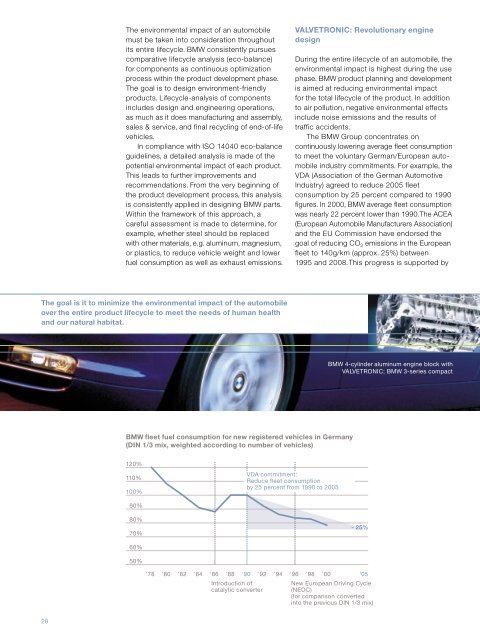


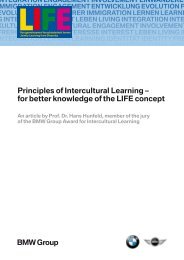
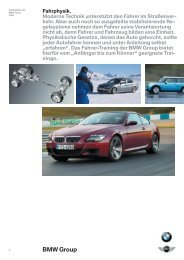

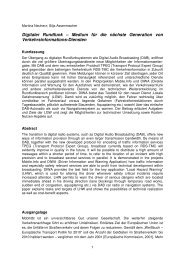
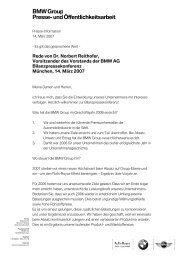
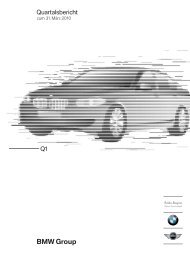

![Vollständiger Bericht [PDF] - BMW Group](https://img.yumpu.com/20706531/1/190x238/vollstandiger-bericht-pdf-bmw-group.jpg?quality=85)
